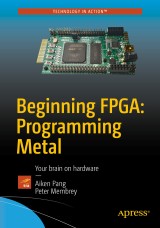Details

Beginning FPGA: Programming Metal
Your brain on hardware|
79,99 € |
|
| Verlag: | Apress |
| Format: | |
| Veröffentl.: | 23.12.2016 |
| ISBN/EAN: | 9781430262480 |
| Sprache: | englisch |
Dieses eBook enthält ein Wasserzeichen.
Beschreibungen
<div><p>Use Arrow's affordable and breadboard-friendly FPGA development board (BeMicro MAX 10) to create a light sensor, temperature sensor, motion sensor, and the KITT car display from Knight Rider.</p>
<p> You don't need an electronics engineering degree or even any programming experience to get the most out of <i>Beginning FPGA: Programming Metal</i>. Just bring your curiosity and your Field-Programmable Gate Array. This book is for those who have tinkered with Arduino or Raspberry Pi, and want to get more hands-on experience with hardware or for those new to electronics who just want todive in.</p>
<p>You'll learn the theory behind FPGAs and electronics, including the math and logic you need to understand what's happening - all explained in a fun, friendly, and accessible way. It also doesn't hurt that you'll be learning VHDL, a hardware description language that is also an extremely marketable skill.</p></div><div><br></div><div><b>What You'll Learn:</b><br></div><div><ul><li>Learn what an FPGA is and how it's different from a microcontroller or ASIC </li><li>Set up your toolchain </li><li>Use VHDL, a popular hardware description language, to tell your FPGA what to be </li><li>Explore the theory behind FPGA and electronics </li><li>Use your FPGA with a variety of sensors and to talk to a Raspberry Pi </li></ul></div><div><br></div><div><b>Who This Book is For:</b></div><div><br></div><div>Arduino, Raspberry Pi, and other electronics enthusiasts who want a clear and practical introduction to FPGA. <br></div>
<p> You don't need an electronics engineering degree or even any programming experience to get the most out of <i>Beginning FPGA: Programming Metal</i>. Just bring your curiosity and your Field-Programmable Gate Array. This book is for those who have tinkered with Arduino or Raspberry Pi, and want to get more hands-on experience with hardware or for those new to electronics who just want todive in.</p>
<p>You'll learn the theory behind FPGAs and electronics, including the math and logic you need to understand what's happening - all explained in a fun, friendly, and accessible way. It also doesn't hurt that you'll be learning VHDL, a hardware description language that is also an extremely marketable skill.</p></div><div><br></div><div><b>What You'll Learn:</b><br></div><div><ul><li>Learn what an FPGA is and how it's different from a microcontroller or ASIC </li><li>Set up your toolchain </li><li>Use VHDL, a popular hardware description language, to tell your FPGA what to be </li><li>Explore the theory behind FPGA and electronics </li><li>Use your FPGA with a variety of sensors and to talk to a Raspberry Pi </li></ul></div><div><br></div><div><b>Who This Book is For:</b></div><div><br></div><div>Arduino, Raspberry Pi, and other electronics enthusiasts who want a clear and practical introduction to FPGA. <br></div>
<p>Part I: Getting Started with FPGA</p><p>1. What is an FPGA and What Can It Do?</p><p>2. Our Weapon of Choice</p><p>3. Lock and Load</p><p>4. Hello World!</p><p>Part II: Time out for Theory</p><p>5. FPGA Development Timeline</p><p>6. VHDL 101</p><p>7. Number Theory for FPGAs</p><p>8. Telling the Truth: Boolean Algebra and Truth Tables</p><p>9. Simplifying Boolean Algebra for FPGA</p><p>10. Sequential Logic: IF this, THEN that</p><p>11. Combinatorial Logic: Putting it all together on the FPGA</p><p>Part III: Let's Make Something!</p><p>12. Light Sensors: Turning a Laser Pointer into a Hi-tech Tripwire</p><p>13. Temperature Sensors: Is it Hot in Here, or Is It Just Me?</p><p>14. How Fast Can You Run? Ask the Accelerometer!</p><p>Part IV: Taking It Further: Talking to the Raspberry Pi and LED Displays</p><p>15. I2C: Two-way Communications with Your Raspberry Pi</p><p>16. Up in Lights: How to Drive LED Segment Displays</p>
<p>Aiken Pang was born in Hong Kong in the early 80s just in time for the home micro-computer revolution. He developed an interest in computers after finding an Apple IIe at his uncle's home, installing a TV card, floppy drive and loaded his first game (Pacman) by himself at the age of 10. Since then he has taught himself a number of programming languages and built his own computers from scratch.<br> <br> Aiken followed his passion for computing into more formal studies and holds a BEng in Electronics Engineering and an MSc in Computer Engineering from the Hong Kong Polytechnic University and the University of Massachusetts at Lowell respectively. He has been using VHDL to design hardware in FPGAs for over 10 years.<br> <br> He lives in the USA with his wife France and their daughter Mayah.</p>
<div>This book is for those who have tinkered a bit with Arduino or Raspberry Pi, and want to get more hands-on with hardware, or for those new to electronics and you just want to dive in.</div> <div><br></div> You don't need an electronics engineering degree or even any programming experience to get the most out of Beginning FPGA: Programming Metal. Just bring your curiosity and your Field-Programmable Gate Array. In this book, you'll be using the Arrow's BeMicro MAX 10 (Altera/Intel FPGA), a very affordable and breadboard-friendly FPGA development board to create a light sensor, an temperature sensor, a motion sensor, and just for fun, the KITT car display from Knight Rider.<br> <p><br>Along the way, you'll learn the theory behind FPGAs and electronics, including the math and logic you need to understand what's happening - all explained in a fun, friendly, and accessible way. It also doesn't hurt that you'll be learning VHDL, a hardware description language that is alsoan extremely marketable skill.</p><p><br></p><p><br></p>
If you've already tinkered a bit with Arduino or Raspberry Pi, and you want to get more hands-on with hardware, or even if you're completely new to electronics and you just want to dive in, then Beginning FPGA is the book you need.
-
-
© 2024 media control GmbH
Alle Preise enthalten die gesetzliche Mehrwertsteuer. - AGB
- Impressum
- Datenschutzerklärung
- Kontakt
- FAQ
- Mein Konto
- Home
- Erweiterte Suche
- Widerrufsrecht
- Reader-Software
- Desktop-Ansicht
- Gutschein-Code einlösen


